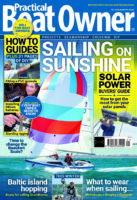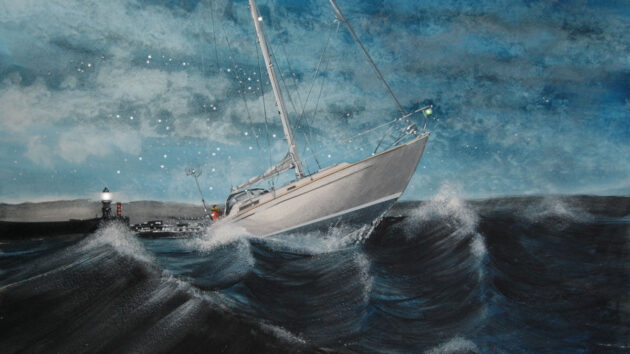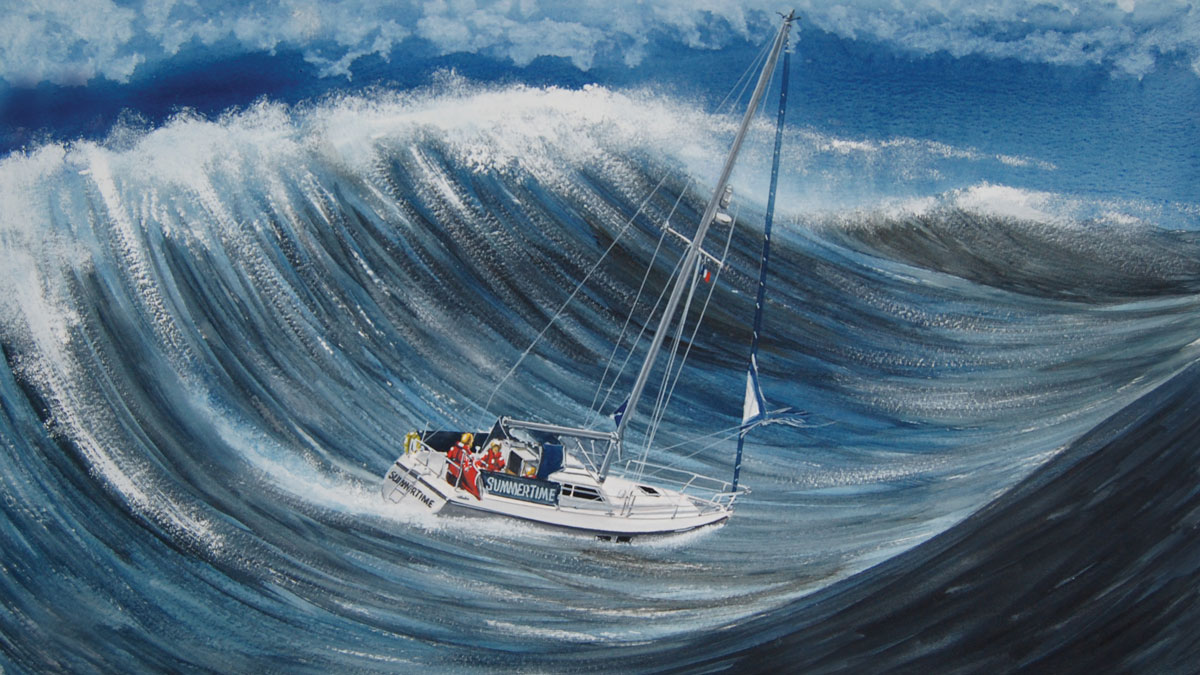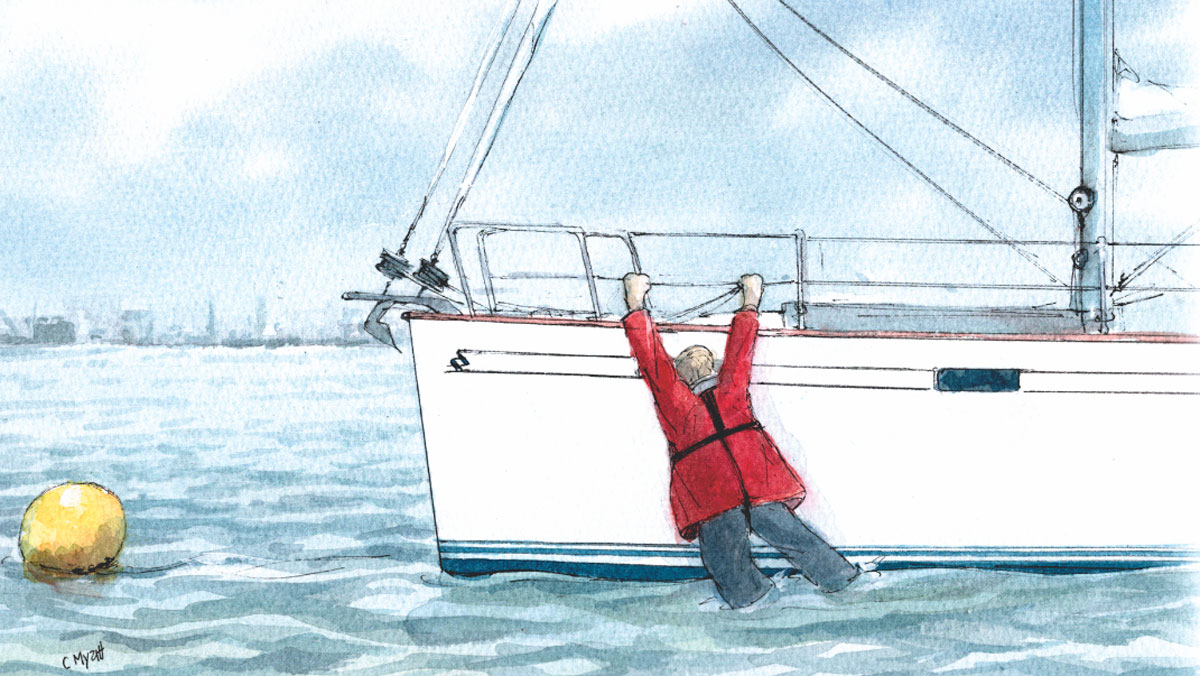Tim Butler had to struggle back to the port he'd just departed when his Helmatic 30 began rolling violently in steep waves and a sudden Force 8
Last October, my good friend moved my Halmatic 30 Excalibur from Chichester up to London for the winter, with stops in Brighton and Dover: however, the forces of nature did their best to scupper our plans. We experienced some pretty awful conditions and learned a number of lessons, so there are many things we will both do differently in the future.
After a relatively easy leg to Dover, we were geared up and ready to go again: we had sailed from Dover to London a few times and didn’t foresee anything out of the ordinary happening. The weather forecast was perfect, Force 4-5 south-westerly.
We expected to be able to sail pretty much all the way, and as it was now Springs we would shoot through Goodwin Sands. HW was at 2345, so we aimed to leave at 2300 and arrive at 1400 the following day. We planned to get through Goodwin Sands, and then I’d get some rest and swap over on the helm with Oliver once we got to the Thames Estuary.
I should mention that the manual bilge pump broke on our first day of departure. I wasn’t particularly happy about being one bilge pump down, but I had an automatic bilge pump which had done a terrific job on our journey to Brighton, so I was confident we wouldn’t be facing anything untoward on our way to London.
Before departure, I made up a flask of tea, pre-filled the mugs with tea bags and sugar and readied some snacks for the journey. Before each trip, I always have a quick scan around the cabin and tidy everything away, so it all looks good.
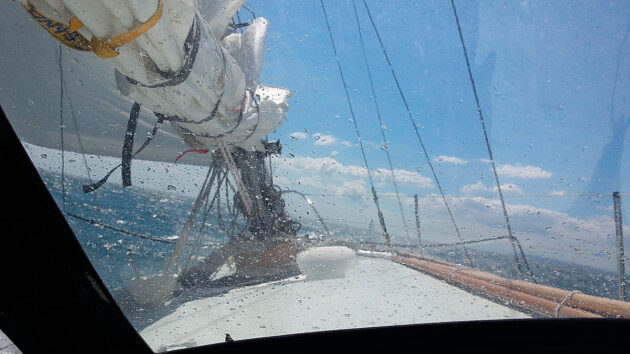
Excalibur on the water in less taxing conditions. Credit: Tim Butler
We departed dead on 2300 as planned and slowly motored towards the western entrance. We could tell the wind was perhaps gusting more than forecasted, so we decided we would motor past the eastern entrance, which the Dover to Calais ferries use, and then get the main up with a reef or two in.
Oliver called up Dover port authorities and requested permission to leave. The traffic lights turned green, so I gave Excalibur a few more revs and set off.
We were both standing on the lockers, keeping a lookout as we approached the entrance. As we got closer, I suggested we both clipped on as the sea beyond looked a bit bumpy: thereafter, I got down into the cockpit and grabbed a cushion so I could rest my knee on a locker while helming.
I mentioned to Oliver that he might also want to join me in the cockpit, and suggested that he put the washboards in. Oliver did so, and we were set in – ready for perhaps a few slams and then we’d be on our way. I even recall saying ‘here we go!’ This gung-ho attitude was soon punched out of me.
‘A Cauldron of Confusion’
The wind suddenly increased to Force 8. With a fast, ripping tide moving north-east and a southerly wind, the water was a cauldron of confusion. The waves were steep and the troughs deep.
Excalibur took a few of these short, steep waves head-on, but it didn’t feel right. We decided to head further out to try escaping the confused seas, but this was no good. The waves seemed to be coming from all directions, and suddenly Excalibur was rolling from side to side.
Each time we listed over it seemed further than the previous time. You know it’s bad when you see the windows go under water, and when you list so far over the water is nearly at the same height as the bottom of the winch: so close that it can’t be long before it fills the cockpit. One particular wave came from nowhere and filled the cockpit to the height of the lockers.
Enough was enough. Oliver quickly called Dover port authorities and explained that we were having some issues and needed to return straight away. The port authority gave us the green light to come back and told us to let them know if we needed any assistance.
I think the wobble in Oliver’s voice said it all: we were both overwhelmed by the situation we were in. Oliver took over to ensure we didn’t broach. We now had to fight the tide and keep the boat as steady as possible, and crab back through the entrance.
It was a seriously intense time: we had already drifted with the tide to about 1 mile out. Fighting the tide, we could only make 2 knots – and we were still in the thick of it. Our worst fears were that the engine would cut out. We were still listing to perhaps 45°, and if the engine stopped, we would most likely be taken into the side of the Dover breakwater.
The engine would rev higher after each bout of being tossed around – I still don’t know why. Engine manufacturers state that the maximum listing at which an engine can function is 30°, so if the engine continued to work above this, then it would be down to good luck.
We edged painstakingly slowly to the entrance, both waiting for that one big wave to push us over, and wondering how much abuse the tiller could take as Oliver wrestled the boat after each wave.
We made our way slowly towards the entrance, crabbing along sideways until things gradually calmed down: and then, to our immense relief, we were in. Shaken and stirred, we motored back to our berth: it took me a while to calm down enough to be able to berth Excalibur. Once we moored up, it was time to assess the damage.
Scattered Items
Down below was a mess. I knew I hadn’t imagined the whole thing when Oliver started relaying the scene to me. The box at the top of the companionway had dispersed my tools and boxes of nails all over the floor, plus a multimeter which had curiously switched itself on.
The Flavel cooker had emptied its contents. The electric kettle and toaster, which I keep in the recessed area by the galley, were on the floor. Items in the trotter box had scattered everywhere. And the nav lights had stopped working, which turned out to be a blown fuse.
We went through three bottles of wine that night, and talked in depth about the things we had learnt. We suddenly realised the importance of the positioning of lifesaving equipment and keeping everything shipshape.
I still can’t believe my most harrowing experience on the water started about 200m from the entrance of Dover port. In conclusion, I’d like to say a big thank-you to Oliver: I wouldn’t want to have faced such conditions with anyone else!
Lessons Learned
1 EPIRBs, liferafts and flares are useless below deck. We had no time to go down below when the situation worsened. All lifesaving equipment belongs up in the cockpit (secured, obviously).
2 Keep drain holes clear – a simple thing, but easily forgotten.
3 Going out without a working manual bilge pump was foolish. Replacing it only took about 40 minutes.
4 Lockers should always be properly closed while en route.
5 An 18hp engine gave us 2 knots against the tide. In a situation like this, Excalibur would have benefited from a more powerful engine to get back in as quickly as possible.
6 The genoa line came loose and trailed in the water: luckily, it didn’t get wrapped around the prop! Lines should always be secured when not in use.
7 One thing we did get right was having the washboards easily accessible. Oliver was able to grab them from the wet locker with his harness still attached.
8 We should have paid more attention to the advice for Dover in the Shell Channel Pilot: ‘In south-westerly gales a very confused and steep swell may develop… exercise extreme caution, especially if they coincide with HW Springs’.
9 Preparation is the key: when things turn bad, they happen in an instant, and by then there’s no time to do all the things you thought you’d be able to.
Force 10 in the Channel: ‘We took a colossal wave broadside, and the cockpit was suddenly knee-deep in water’
A routine Channel crossing became a nerve-shredding passage when a ferocious storm hit, as Ron Stride recalls
Baptism of fire: Sailing Biscay in a Force 8 on my first (and last) yacht delivery
Despite having never had aspirations to be a yacht delivery skipper, I was coerced into delivering a Moody 426 from…
Lessons learned from sailing home in a Force 5 after engine failure
Philip, my husband, needed the car so I decided to take my Offshore 8m Karima S from Aith to Brae,…
‘In a flash, I was hanging on the lifelines on the wrong side of the boat’
Solo sailor Tony Purcell discovered how quickly a tricky situation can develop when he fell overboard his 42ft yacht on…
Want to read more articles like “A Force 8 gale turned the sea off Dover into a ‘cauldron of confusion’ that nearly overwhelmed our Halmatic 30”?
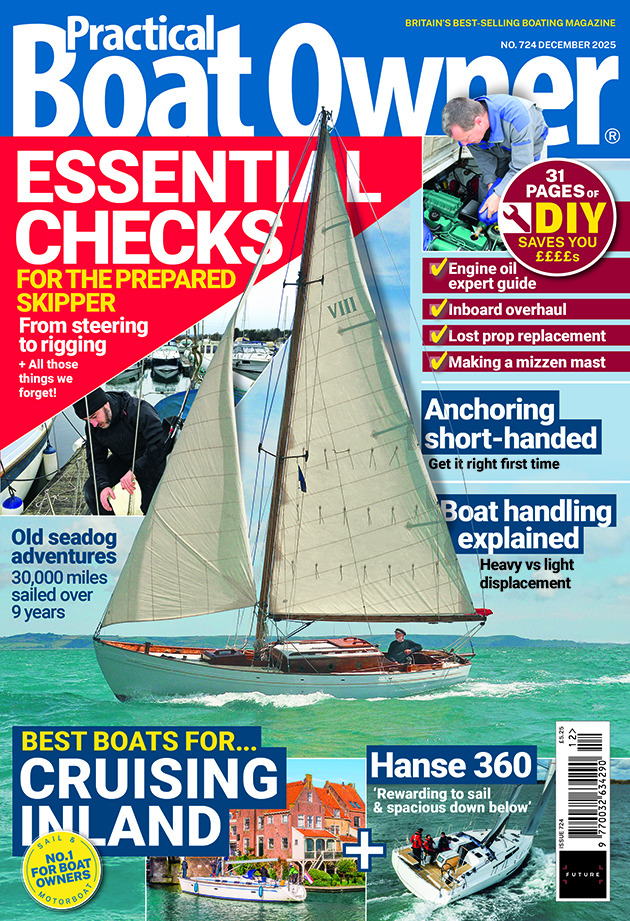
A subscription to Practical Boat Owner magazine costs around 40% less than the cover price.
Print and digital editions are available through Magazines Direct – where you can also find the latest deals.
PBO is packed with information to help you get the most from boat ownership – whether sail or power.
-
-
-
- Take your DIY skills to the next level with trusted advice on boat maintenance and repairs
- Impartial, in-depth gear reviews
- Practical cruising tips for making the most of your time afloat
-
-
Follow us on Facebook, Instagram, TikTok and Twitter

